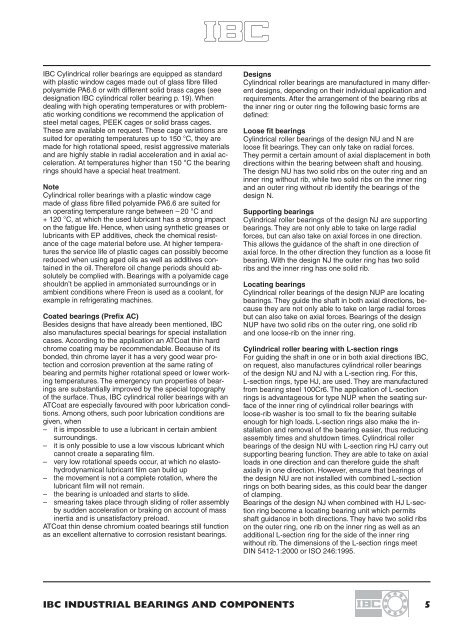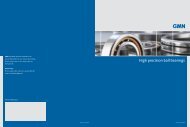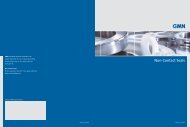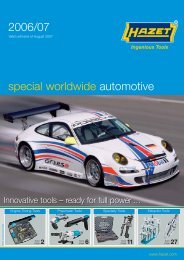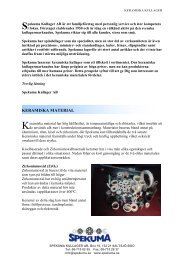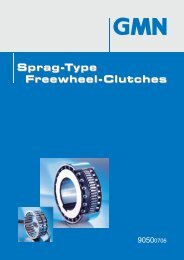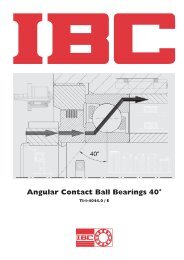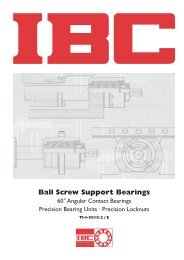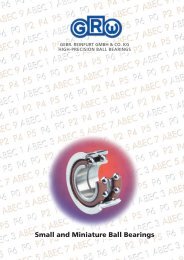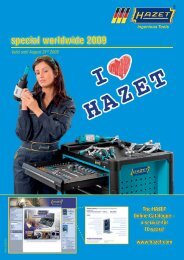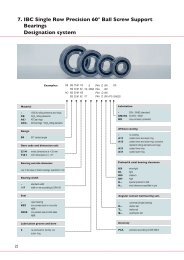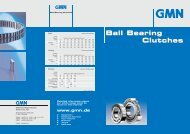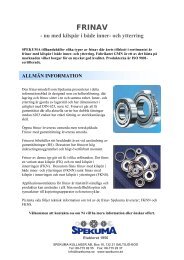IBC Cylindrical Roller Bearings - Spekuma Kullager AB
IBC Cylindrical Roller Bearings - Spekuma Kullager AB
IBC Cylindrical Roller Bearings - Spekuma Kullager AB
You also want an ePaper? Increase the reach of your titles
YUMPU automatically turns print PDFs into web optimized ePapers that Google loves.
<strong>IBC</strong> <strong>Cylindrical</strong> roller bearings are equipped as standard<br />
with plastic window cages made out of glass fibre filled<br />
polyamide PA6.6 or with different solid brass cages (see<br />
designation <strong>IBC</strong> cylindrical roller bearing p. 19). When<br />
dealing with high operating temperatures or with problematic<br />
working conditions we recommend the application of<br />
steel metal cages, PEEK cages or solid brass cages.<br />
These are available on request. These cage variations are<br />
suited for operating temperatures up to 150 °C, they are<br />
made for high rotational speed, resist aggressive materials<br />
and are highly stable in radial acceleration and in axial acceleration.<br />
At temperatures higher than 150 °C the bearing<br />
rings should have a special heat treatment.<br />
Note<br />
<strong>Cylindrical</strong> roller bearings with a plastic window cage<br />
made of glass fibre filled polyamide PA6.6 are suited for<br />
an operating temperature range between – 20 °C and<br />
+ 120 °C, at which the used lubricant has a strong impact<br />
on the fatigue life. Hence, when using synthetic greases or<br />
lubricants with EP additives, check the chemical resistance<br />
of the cage material before use. At higher temperatures<br />
the service life of plastic cages can possibly become<br />
reduced when using aged oils as well as additives contained<br />
in the oil. Therefore oil change periods should absolutely<br />
be complied with. <strong>Bearings</strong> with a polyamide cage<br />
shouldn’t be applied in ammoniated surroundings or in<br />
ambient conditions where Freon is used as a coolant, for<br />
example in refrigerating machines.<br />
Coated bearings (Prefix AC)<br />
Besides designs that have already been mentioned, <strong>IBC</strong><br />
also manufactures special bearings for special installation<br />
cases. According to the application an ATCoat thin hard<br />
chrome coating may be recommendable. Because of its<br />
bonded, thin chrome layer it has a very good wear pro -<br />
tection and corrosion prevention at the same rating of<br />
bearing and permits higher rotational speed or lower working<br />
temperatures. The emergency run properties of bearings<br />
are substantially improved by the special topography<br />
of the surface. Thus, <strong>IBC</strong> cylindrical roller bearings with an<br />
ATCoat are especially favoured with poor lubrication conditions.<br />
Among others, such poor lubrication conditions are<br />
given, when<br />
– it is impossible to use a lubricant in certain ambient<br />
surroundings.<br />
– it is only possible to use a low viscous lubricant which<br />
cannot create a separating film.<br />
– very low rotational speeds occur, at which no elasto -<br />
hydrodynamical lubricant film can build up<br />
– the movement is not a complete rotation, where the<br />
lubricant film will not remain.<br />
– the bearing is unloaded and starts to slide.<br />
– smearing takes place through sliding of roller assembly<br />
by sudden acceleration or braking on account of mass<br />
inertia and is unsatisfactory preload.<br />
ATCoat thin dense chromium coated bearings still function<br />
as an excellent alternative to corrosion resistant bearings.<br />
Designs<br />
<strong>Cylindrical</strong> roller bearings are manufactured in many different<br />
designs, depending on their individual application and<br />
requirements. After the arrangement of the bearing ribs at<br />
the inner ring or outer ring the following basic forms are<br />
defined:<br />
Loose fit bearings<br />
<strong>Cylindrical</strong> roller bearings of the design NU and N are<br />
loose fit bearings. They can only take on radial forces.<br />
They permit a certain amount of axial displacement in both<br />
directions within the bearing between shaft and housing.<br />
The design NU has two solid ribs on the outer ring and an<br />
inner ring without rib, while two solid ribs on the inner ring<br />
and an outer ring without rib identify the bearings of the<br />
design N.<br />
Supporting bearings<br />
<strong>Cylindrical</strong> roller bearings of the design NJ are supporting<br />
bearings. They are not only able to take on large radial<br />
forces, but can also take on axial forces in one direction.<br />
This allows the guidance of the shaft in one direction of<br />
axial force. In the other direction they function as a loose fit<br />
bearing. With the design NJ the outer ring has two solid<br />
ribs and the inner ring has one solid rib.<br />
Locating bearings<br />
<strong>Cylindrical</strong> roller bearings of the design NUP are locating<br />
bearings. They guide the shaft in both axial directions, because<br />
they are not only able to take on large radial forces<br />
but can also take on axial forces. <strong>Bearings</strong> of the design<br />
NUP have two solid ribs on the outer ring, one solid rib<br />
and one loose-rib on the inner ring.<br />
<strong>Cylindrical</strong> roller bearing with L-section rings<br />
For guiding the shaft in one or in both axial directions <strong>IBC</strong>,<br />
on request, also manufactures cylindrical roller bearings<br />
of the design NU and NJ with a L-section ring. For this,<br />
L-section rings, type HJ, are used. They are manufactured<br />
from bearing steel 100Cr6. The application of L-section<br />
rings is advantageous for type NUP when the seating surface<br />
of the inner ring of cylindrical roller bearings with<br />
loose-rib washer is too small to fix the bearing suitable<br />
enough for high loads. L-section rings also make the installation<br />
and removal of the bearing easier, thus reducing<br />
assembly times and shutdown times. <strong>Cylindrical</strong> roller<br />
bearings of the design NU with L-section ring HJ carry out<br />
supporting bearing function. They are able to take on axial<br />
loads in one direction and can therefore guide the shaft<br />
axially in one direction. However, ensure that bearings of<br />
the design NU are not installed with combined L-section<br />
rings on both bearing sides, as this could bear the danger<br />
of clamping.<br />
<strong>Bearings</strong> of the design NJ when combined with HJ L-section<br />
ring become a locating bearing unit which permits<br />
shaft guidance in both directions. They have two solid ribs<br />
on the outer ring, one rib on the inner ring as well as an<br />
additional L-section ring for the side of the inner ring<br />
without rib. The dimensions of the L-section rings meet<br />
DIN 5412-1:2000 or ISO 246:1995.<br />
<strong>IBC</strong> INDUSTRIAL BEARINGS AND COMPONENTS 5


